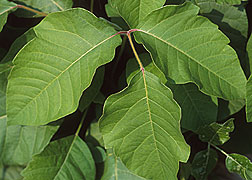Toxicodendron radicans, a.k.a. Rhus radicans
How to Identify Poison Ivy
Poison ivy takes many forms, so it is particularly important for parents, camp counselors, hikers, gardeners, and anyone who enjoys the outdoors to become familiar with its characteristics in all seasons. It can grow as a sprawling ground cover, a woody shrub, or a woody vine climbing fences, trees, telephone poles, or even buildings in more rural areas. Urushiol, the resin responsible for producing allergic reactions in people, is present in every part of the plant. Rashes can appear minutes or days after exposure. People may also experience allergic reactions if exposed to fumes from burning the plant.
Poison ivy is native to the United States and is easily spread by seeds eaten by birds that feed off the white berries produced in the fall. Plants frequently grow at the edge of woodlands and roadsides, hugging sand dunes, and creeping along residential alleys, forest preserves, and campsites. It is an opportunistic plant and will spread if not checked.

Close-up of poison ivy leaves
General Description
"Leaves of three, let them be," is a good rhyme to remember since a key identifying feature of poison ivy is its compound leaf composed of three leaflets. Each leaflet can be between 2 and 4 inches long, with pointed tips. The middle leaflet is generally the largest of the three. The leaflets might be shiny or dull (or a combination of the two), and the margins of the leaflets might be toothed or smooth. These variable characteristics can frustrate those looking to easily identify poison ivy. The leaves grow alternately on a plant’s stem as opposed to plants whose leaves grow opposite each other. In spring, the emerging leaflets often take on a shiny reddish-green cast, and in fall the plant will turn scarlet if grown in full sun. Two plants that are often confused with poison ivy are Virginia creeper (Parthenocissus quinquefolia) and fragrant sumac (Rhus aromatica).
Stems
When growing as a vine clinging to a support, the main woody stem may produce hundreds of tiny aerial roots. As a rambling ground cover, the stems usually remain greener and less woody.
Flowers and Fruit
In late spring to early summer, the plant produces clusters of insignificant greenish flowers located in the axils of the leaves. As summer progresses, these flowers develop into grayish-white waxy berries with lines on their surfaces. Each berry is less than ¼ inch in diameter.
How to Control Poison Ivy
There are several methods of control available to gardeners, depending on the size of the plant and the time of year it is discovered. Use caution and wear protective clothing, shoes, and several pairs of gloves, since urushiol will remain on any clothing it contacts.
CUTTING
In spring, cut the emerging ground cover shoots to the ground. Repeat this process as soon as new shoots are discovered, and continue cutting until the plant no longer produces shoots. Cutting shoots is most effective when they are just beginning to sprout. When cutting a woody vine, sever the vine close to ground level and paint the stump with an approved herbicide. Multiple applications over a period of time are often necessary to kill the vine.
DIGGING
Young plants can be removed by digging when the soil is moist. Take care to remove as much of the root system as possible, as well as all above-ground growth. Since this process brings the gardener very close to the plant, great care must be taken not to spread the resin on clothing, tools, gloves, or garbage bags.
HERBICIDES
Poison ivy leaves can be painted or sprayed with an approved herbicide, which is best accomplished early in the season when the leaves are just emerging. Spraying is not recommended if the poison ivy is growing in the middle of a garden area or is attached to a tree or shrub.
Please contact Plant Information Service at (847) 835-0972 or via email at Click here to show mail address for information about identification and removal of poison ivy, as well as current herbicide recommendations.

